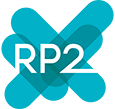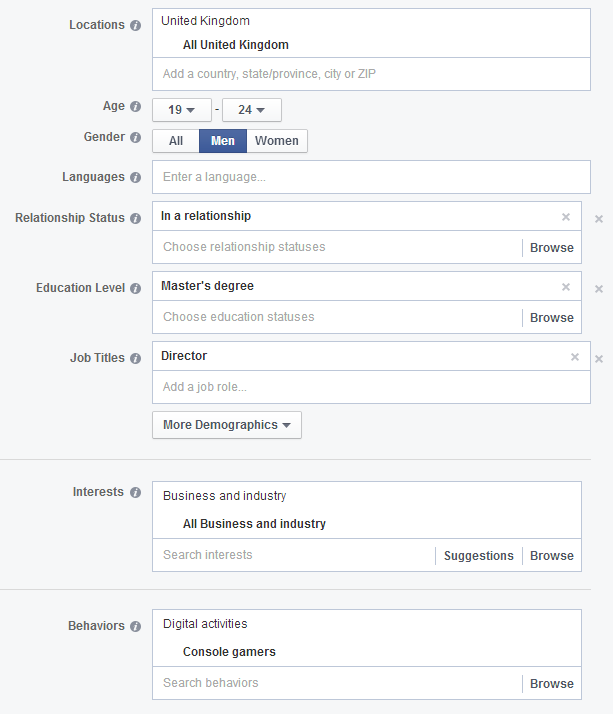The author’s posts are entirely his or her own (excluding the unlikely event of hypnosis) and may not always reflect the views of Moz.
As much as content and advertising agencies would like you to believe it, content produced by a business doesn’t just go viral on it’s own. There is often something that pushes it really, really hard when it first goes live which gains momentum, and eventually the content is spread far and wide enough that it doesn’t need you to push it anymore. Those of you who have read Good to Great may be making associations with the flywheel principle, but that’s a post for another day!
In this post I want to talk about one of the ways you can give your content a nudge in the right direction and get more people looking at it: Facebook advertising.
I won’t go into too much detail on the basics of Facebook advertising; there are lots of resources and posts out there which do this. Instead, I want to dive straight into the methods you can use to promote your content to an audience on Facebook.
One of the advantages of using Facebook is the fine level of detail you can go to in terms of targeting an audience. In my opinion, this is one of the areas where Facebook is actually better than Google when it comes to advertising. They have so many options when it comes to targeting your audience:
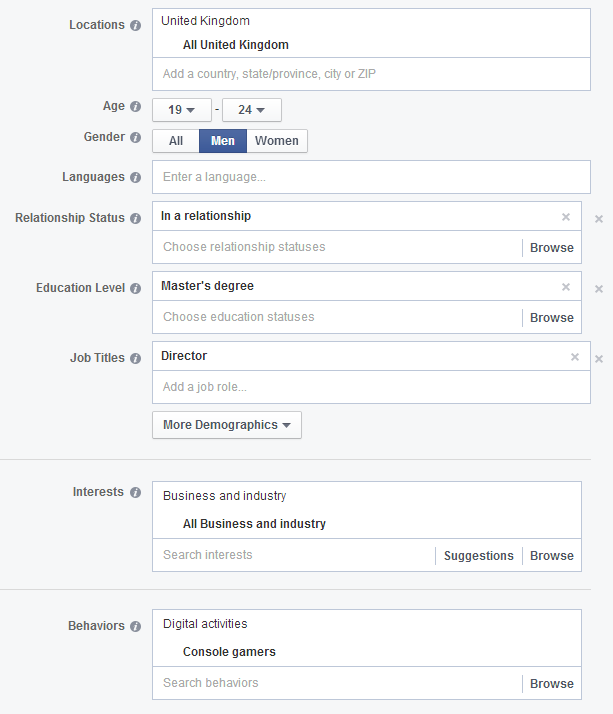
You can go much deeper
What isn’t as well known, however, is that you can define your own audiences on Facebook and advertise to them directly. There are two core ways that you can do this which I’ll explain in this post:
- Custom audiences
- Lookalike audiences
These methods allow you to push your content to a wider audience, but in a very targeted way. Yes, you are paying to advertise your content, which may feel a bit strange. However, it can be a great way of supporting your outreach and PR efforts.
Let’s explore each one.
Custom audiences
You can use a feature called custom audiences to define exactly who it is that you’d like to advertising your content to.
Why this is useful for content promotion
When it comes to promoting your content, getting a lot of traffic to the content is good, but ideally you don’t just want random visitors, you want targeted visitors. Whilst it is unlikely that you’ll generate loads of direct conversions from a piece of content, you still want to attract visitors who you stand a chance of converting to customers at some point in the future.
As you can see above, you can get very granular with standard Facebook targeting. Custom audiences allow you to do even more and mix in data from your existing, non-Facebook customer lists too. This means that you can promote your content to an audience that is already somewhat engaged with your brand and is a little bit more likely to be interested in it. This is far better than a scatter-gun approach where you just try and get as many eyes on a piece of content as possible – regardless of how targeted they are.
Facebook gives you a number of ways to define your custom audience:
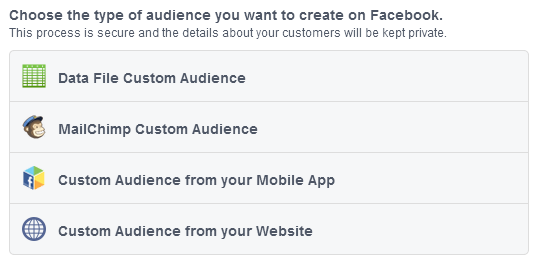
Let’s go through each of these in turn and look at what they can do.
Data file custom audience
This option allows you to upload a CSV file which Facebook will then process to try and find matches with people who are already on Facebook. There are a few options in terms of what data you can upload and use to match people against:
- Email address
- Facebook User ID
- Phone number
- Mobile advertiser ID (such as Android or Apple user ID)
Once you’ve uploaded the file, it shouldn’t take Facebook more than an hour or so to process the file and find matches from its users. Note that you need to upload a decent number of records in order to target them, Facebook recommends at least 100 people. Otherwise, the audience is likely to be too small to have any kind of impact or reach.
After processing, you’ll see that the audience you’ve just created will be available to advertise to when you create a new ad:

From here, you can just create an ad as normal but it will be targeted just at this list of people.
MailChimp custom audience
I love MailChimp, we use it all the time at Distilled. Facebook makes it super easy to connect to your MailChimp account and target your email list.
If you have a list of customers or newsletter subscribers, then they are already familiar with your brand. So targeting them and showing off your awesome content could help bring them back to your website in a way that isn’t directly sales / conversion focused. This can also work well to try and drive more traffic to your Facebook page or to generate likes, etc.
Custom audience from your mobile app
I haven’t had the opportunity to try this one yet, but it’s clear that it could be pretty powerful if you have a mobile app and are able to integrate the Facebook SDK for iOS or Android.
Basically, you can record user interactions with your app and choose to bucket people who take certain actions into a custom audience.
Custom audience from your website
This feature allows you to track visitors to your website using a Facebook remarketing pixel. Once you’ve installed the pixel, Facebook will begin building a list of visitors to your page who are also logged into Facebook and push these people into a custom audience. There are loads of ways to use this, but I’ll come onto a very specific way you can use this shortly.
Lookalike audiences
There is a lot of power in the lookalike audiences feature on Facebook, I’ll talk through a few examples, but first, let me briefly explain what lookalike audiences are in case you’re not familiar.
Facebook allows you to say, “hey, here is a list of my existing customers, go find me people on Facebook who are similar to them and put those people into a new list.”
I don’t know the secret sauce or methodology that Facebook uses here, but I’d imagine it’s a case of mashing together things like:
- Demographic data
- Interests
- What someone has liked
- Location
Once they’ve discovered the trends in this data, they find other people on Facebook who share these trends and put them into a new list. You can then push adverts for your content towards this list of people.
Why this is useful for content promotion
The beauty of this method is that you’re reaching a brand new audience in a very, very targeted way. Again, it’s not a scatter-gun approach of just trying to target as many people as possible. Instead, you’re targeting people who look very similar to your existing audience.
How to create a lookalike audience
Facebook makes it really easy, you go to Facebook Ads and click on the following:
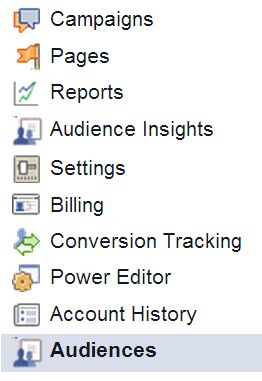
Then click on:

You will then see something like this:
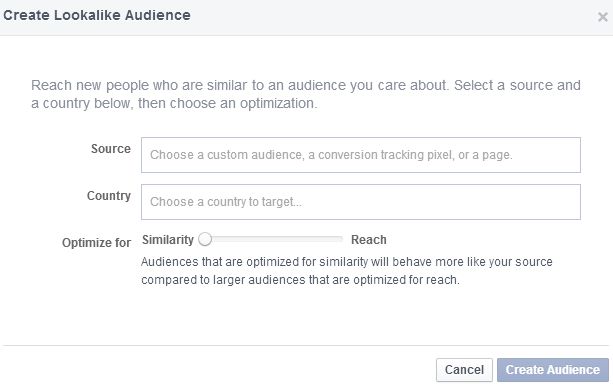
You can choose the source of your lookalike audience which, as you can see, can be either:
- An existing custom audience
- A conversion tracking pixel
- A Facebook page
I’ll go into detail on these shortly and give some examples of what you can do here.
Next, you need to choose a country for your audience. Currently, Facebook only allows you to select one country at a time. So if you wanted to create lookalike audiences across lots of countries, you’ll need to create a lookalike list for each country.
The final option is to tell Facebook what balance you want between a new audience that is similar to your existing audience vs. the reach of the new audience. If you’re starting off with a pretty small audience, then you may have to move the needle more towards reach, but I’d generally try and keep things as closely related to your existing audience as possible. Otherwise you’re losing the benefits that a lookalike audience gives you.
Once you’ve created your audience, it will be available to you in the dropdown menu when you create a new ad:

Next, let’s get into some examples of how you can use lookalike audiences to get more relevant eyes on your content.
Create a lookalike audience based on your email list
Above, we talked about how you can create a custom audience by uploading a list of customer email addresses or syncing Facebook with your MailChimp account. This alone is pretty powerful, but you can also use your email list as a source of a lookalike audience. You’ll need to create a custom audience first, but once you do, you can use this as a source and tell Facebook to find you a whole new audience who look like your existing email list.
This is really useful if you have:
- A list of customer email addresses
- A list of subscribers to your blog content
- A list of newsletter subscribers
Create a lookalike audience based on visitors to your content
You can’t really do this one in advance of launching your content, but I think it can be a very powerful method of extending the reach of your content in a very targeted way. What we’re going to do is track all the people who view our content, then ask Facebook to find us a new audience who look like those people. Let me illustrate with an example using this piece of content we created at Distilled:
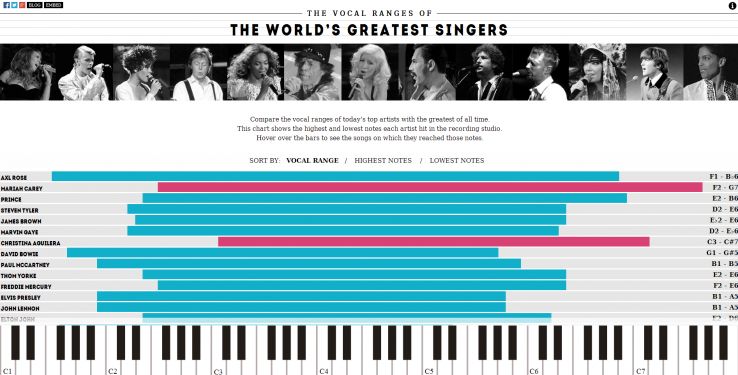
It stands to reason that people who click through to this piece of content are probably going to share a few things:
- An interest in music
- An interest in one or more of the singers mentioned in the list
- Probably someone who attends live music from time to time
If we placed a Facebook conversion pixel on this page, Facebook will detect those people who view the content and are logged into Facebook at the same time. This means that when grouping all those people together, Facebook will probably find shared interests, demographics and likes which they can use to define a new lookalike audience. In this example, the new audience is likely to be interested in music and gigs.
If we then advertise this content to this new audience, it’s likely to get their attention because they will be similar to the existing audience who are already viewing the content. This is super, super targeted.
So how do you do this?
The first step is to place a Facebook conversion pixel on your piece of content. You can do this by following these steps.
Click on conversion tracking:
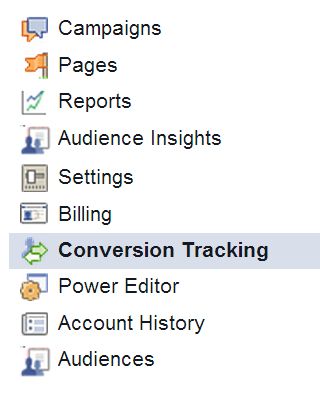
Click on create pixel:

Now you have some options to select:
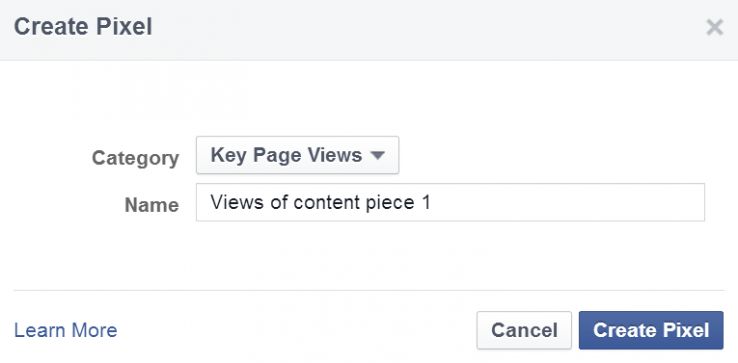
Next, Facebook will give you some tracking code which you need to paste it into the <head> section of your page.
Once you’ve done this, Facebook will start tracking the pixel and you’ll see a new row in your conversion tracking report:

It will take a bit of time for data to start coming in, but when it does and you’ve reach a good amount of views, you can create a lookalike audience by clicking on:
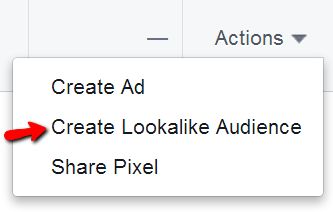
That’s it! You can then select this new lookalike audience when you create an ad and push adverts for your content towards people who share the same attributes of people already viewing your content.
To wrap things up
Hopefully you can see the power of Facebook ads, in particular the custom and lookalike audience features to help you promote your content in a very, very targeted way. It may feel a bit unnatural to pay to promote content (and not your product) but this is a very cost-effective way of reaching a big audience and it can really help support your regular outreach efforts.
